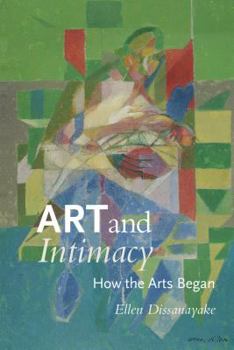Art and Intimacy: How the Arts Began
Select Format
Select Condition 
Book Overview
To Ellen Dissanayake, the arts are biologically evolved propensities of human nature: their fundamental features helped early humans adapt to their environment and reproduce themselves successfully over generations. In Art and Intimacy she argues for the joint evolutionary origin of art and intimacy, what we commonly call love. It all begins with the human trait of birthing immature and helpless infants. To ensure that mothers find their demanding babies worth caring for, humans evolved to be lovable and to attune themselves to others from the moment of birth. The ways in which mother and infant respond to each other are rhythmically patterned vocalizations and exaggerated face and body movements that Dissanayake calls rhythms and sensory modes. Rhythms and modes also give rise to the arts. Because humans are born predisposed to respond to and use rhythmic-modal signals, societies everywhere have elaborated them further as music, mime, dance, and display, in rituals which instill and reinforce valued cultural beliefs. Just as rhythms and modes coordinate and unify the mother-infant pair, in ceremonies they coordinate and unify members of a group. Today we humans live in environments very different from those of our ancestors. They used ceremonies (the arts) to address matters of serious concern, such as health, prosperity, and fecundity, that affected their survival. Now we tend to dismiss the arts, to see them as superfluous, only for an elite. But if we are biologically predisposed to participate in artlike behavior, then we actually need the arts. Even -- or perhaps especially -- in our fast-paced, sophisticated modern lives, the arts encourage us to show that we care about important things.
Format:Hardcover
Language:English
ISBN:0295979119
ISBN13:9780295979113
Release Date:January 2000
Publisher:University of Washington Press
Length:265 Pages
Weight:1.32 lbs.
Dimensions:0.9" x 6.3" x 9.3"
Customer Reviews
1 rating
A Book of Great Beauty and Vast Riches
Published by Thriftbooks.com User , 22 years ago
I have been trying for some time to write a review of this book. I give up: I simply cannot do it justice in 1,000 words or less. The book is not flawless, but in the two years since I first read it, I have come back to it again and again, always learning something. It took a long time to read in the first place, because every few pages I would run into an idea that required a few days' thought. The book is illustrated with wonderful photos. Nobody can look at those babies in Chapter 1 without smiling, thus proving Dissanayake's points. My particular favorite is the little girl in Sudan absorbed in her drawing (p197). Some photos I wish had been bigger. The mbari house on page 153 is barely distinguishable. Anybody interested in human affairs will benefit from this book. Even those outside human concerns should read it, simply to see how perceptive and stimulating the ideas are.





